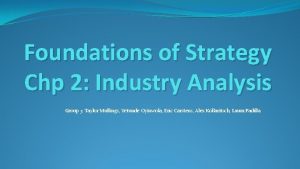Foundations of Strategy Industry Analysis Nicholas Sharp Nicholas






















- Slides: 22

Foundations of Strategy: Industry Analysis Nicholas Sharp Nicholas Dieter Homar Builtron Troy Harris

Introduction The main focus of this chapter is to identify the sources of profit in the external environment.

Colorado Marijuana-Growing Industry ● ● ● ● ● Legalized in 2014 Existing banks and venture capital funds were unwilling to invest in the industry because it was still federally illegal This created an opportunity for new sources of investment companies, such as Privateer Holdings from Seattle Marijuana is the third fastest growing industry in the US behind 3 D printing and cloud computing Potential net profit is 55% higher than costs, but most suppliers only report about 6% This could lead from the high cost of marijuana Very complex process The industry was growing fast despite all of the legal barriers and regulations Competition heated up in the industry and from outside with the illegal sale from Mexico, as well as cocaine, meth, and ecstasy To get an idea of how the industry might evolve, tobacco is a close relative and is also hit with a lot of regulations, but still remains one of the most profitable industries in the US

Environmental Analysis PEST - Political, economic, social, and technology Simple yet systematic approach to identifying factors likely to shape the competitive conditions in the industry Very important to focus on the factors that will affect the industry the most Proximity - Micro, or task environment can be distinguished from the wider influences of the macro -environment

Illustration of PEST from Colorado Marijuana Industry Political - Licensing Taxation Trademarks and intellectual property Economic - Cost of labor, capital, and energy Level of economic activity Social - Shifting attitude towards use Technological - Use of advanced Greenhouses Automated fertilizer and irrigation

Illustration of PEST from Wireless Telecommunications Carriers Industry Political - AT&T Possible Monopoly Censorship Abroad $1. 5 Billion Fine by the EU Economic - Emergence of Straight Talk Wireless (Trac. Phone) Increased State Taxes in California (Possible Relocation) Social - Customers attitudes towards privacy Technological - Constant New Product Development Artificial Intelligence Research Making your phone your key to your kingdom (Apple Pay, Thermostat Control, TV Remote)

From PEST to Industry Analysis The national/international economy Technology The natural environment The Industrial Environment - Suppliers - Competitors - customers Government and politics Demographic Structure Social Structure

Industry Attractiveness ● Some industries earn higher profits than others ○ ○ ● Pharmaceutical companies make more than personal computer companies This can come from the fact that people are not price sensitive for medication, but they are for computers, so there is far more competition leading to lower profits Niche markets can become very desirable because there is a smaller target market, so one firm can easily dominate and earn very high profit ○ ○ Example: Chewing Tobacco is dominated by one company that has 55% of the market share. It has established brands and advertisement that makes it extremely hard for others to join the market. Has 63% ROCE annually Google created a niche market by creating their search engine.

Porter’s Five Forces of Competition https: //www. isaca. org/Journal/archives/2015/Volume-1/Publishing. Images/15 v 1 -Porters-Elements. jpg

The Structural Determinants of the Five Forces of Competition https: //slideplayer. com/slide /10348523/35/images/10/T he+Structural+Determinant s+of+Competition. jpg

Competition from Substitutes Customers are more or less price sensitive based on availability of substitutes - Gas needs to be bought, so price does not necessarily affect demand Internet has made travel agencies and newspapers much more obsolete because of the access to alternative modes of searching for information

Google’s Competition from Substitutes - Their primary competition is Microsoft’s search engine Bing and Yahoo’s search engine - - When it comes to phone software, Google’s only competition is Apple’s IOS software - - In order not to be overcome by these two, Google has to upkeep their brand image Google also needs to keep their name relevant to where you automatically say, “I don’t know this, I need to Google it” Has to keep up with Apple’s software updates and releases to keep current customers Has to be innovative and offer new options to gain new customers In the PC industry, Google’s Chromebook is going against Microsoft Windows and Apple’s Mac OS software

Threat of Entry The more profit the companies in an industry earn, the more likely other companies try to enter that market. - This will lead to a loss of profit towards the competitive level.

Barriers to Entry - Capital needed to establish a business Economies of scale require large scale businesses Absolute advantage of established firms Product differentiation of well known brands Access to distribution Governmental and legal barriers Retaliation of established firms in the form of increased activity in the market or even litigation - Tucker video in ISQS 3344

Barriers to Entry-Google - New competitors would need billions to get started Existing competitors face the challenge of how strong Google’s brand is Human capital would be extremely high since competitors would need high level innovators and programmers

Rivalry between Established Competitors Results from interaction between five factors 1. Concentration a. 2. Diversity of competitors a. 3. The more similar between companies, the more likely a customer is to switch Excess capacity and exit barriers a. 5. If they are very similar, like the car industry beforeign cars, they can avoid price competition Product differentiation a. 4. Number and size distribution of firms in the market Excess leads to price cuts to attract business. Exit barriers are how much it costs to leave the industry Cost conditions: scale economies and the ratio of fixed to variable costs a. The relationship between fixed costs and variable costs i. Firms will try to gain any business possible that will at least cover the variable costs ii. Leads to price wars and industry-wide losses

Bargaining Power of Buyers Buyer’s price sensitivity - Greater the importance as a proportion of total costs, the more sensitive about price they are The more similar products are, the more willing a buyer is to switch based on price The more intense the competition between the buyers, the more they want lower prices If the product is critical to the buyer’s product, they are less sensitive to price Relative bargaining power - How much it costs to NOT do business for each party Size of buyers and how many there are close to the suppliers Buyer’s information The better informed the buyer about the supplier and their costs, the better the ability to bargain Ability to integrate vertically When you refuse the deal with the other party, the alternative to finding another buyer or seller, is to do it yourself. Walmart and Great Value

Bargaining Power of Suppliers - The key issues are the ease with which firms in the industry can switch between different input suppliers and the relative bargaining power of each party - With that being said, Google has a low bargaining power of suppliers. - There are few suppliers who can produce and offer key components for Google and it’s industry

Segmentation Analysis - Is the processes of partitioning a market on the basis of characteristics that are likely to influence consumers’ purchasing behavior Made up of 5 steps 1. Identify Possible Segmentation variables 2. Construct a Segmentation Matrix 3. Analyse segment attractiveness 4. Identify key success factors in each segment 5. Select segment focus This is a review of what we learned in Intro to Marketing

Key Success Factors - Start by asking two questions, “What do our customers want? ” and “What does the firm need to do to survive competition? The first question makes companies look more closely at customers of the industry and not view them as a threat to profitability The second question requires firms to examine the nature of competition in their industry. Once these questions are answered, companies can pinpoint their key success factors

Google’s Key Success Factors - What do their customers want? - - Easy access to information on the internet, software that is easy to understand work with, and newer and updated products What does Google need to do to survive competition? - Upkeep their brand image, continue to innovate, be diligent in protecting users privacy, and not censor information on their webpage

Questions?
 Hotel industry foundations & introduction to analytics
Hotel industry foundations & introduction to analytics Nicholas bishop industry
Nicholas bishop industry Economic foundations of strategy
Economic foundations of strategy Tailoring strategies to fit specific industry
Tailoring strategies to fit specific industry Talent strategy in travel industry
Talent strategy in travel industry Blackboard xythos
Blackboard xythos Disposal alert symbol
Disposal alert symbol Report sharp shooter
Report sharp shooter David sharp últimas palabras
David sharp últimas palabras Sharp object safety symbol
Sharp object safety symbol Sharp object safety symbol
Sharp object safety symbol Askov dental program
Askov dental program How to calculate nerve conduction velocity
How to calculate nerve conduction velocity No sharp edges
No sharp edges Greek or latin root/affix aer
Greek or latin root/affix aer Psc sleeper dimensions
Psc sleeper dimensions Winter moon langston hughes
Winter moon langston hughes Nipponkoku
Nipponkoku Differences between the male and female skeleton
Differences between the male and female skeleton Sharp el-546x
Sharp el-546x Eze sharp
Eze sharp Sharp separation
Sharp separation Sharp, jagged, graceful, smooth
Sharp, jagged, graceful, smooth










































